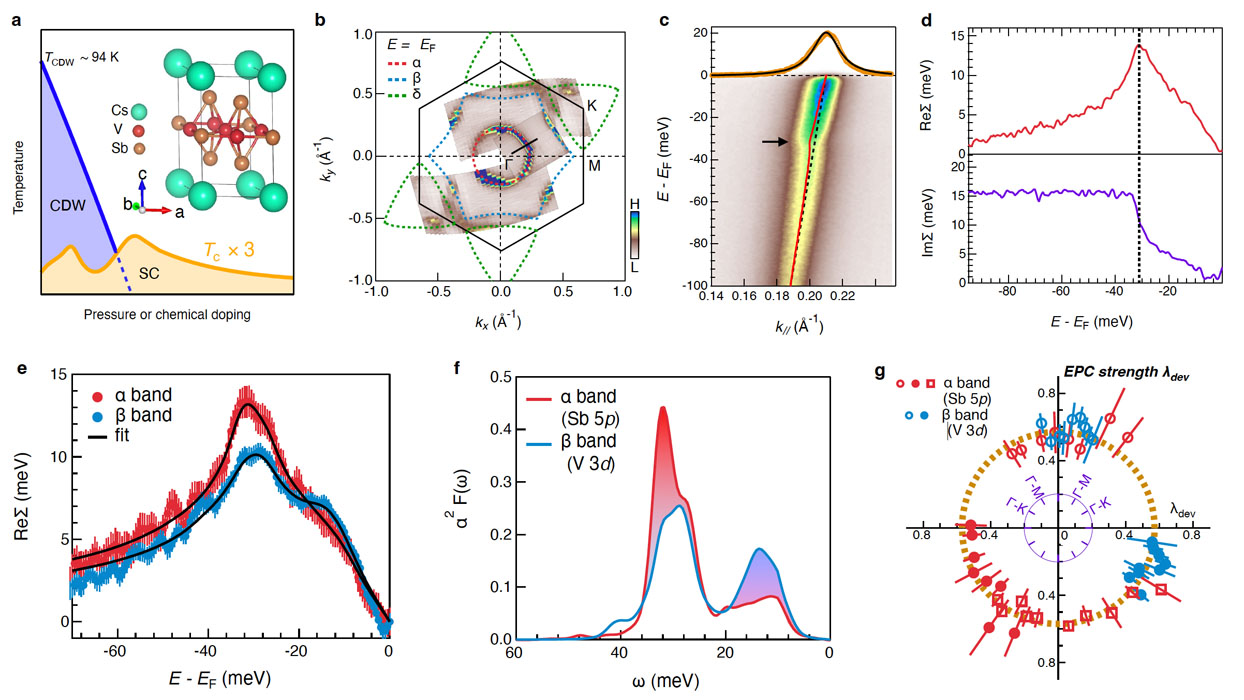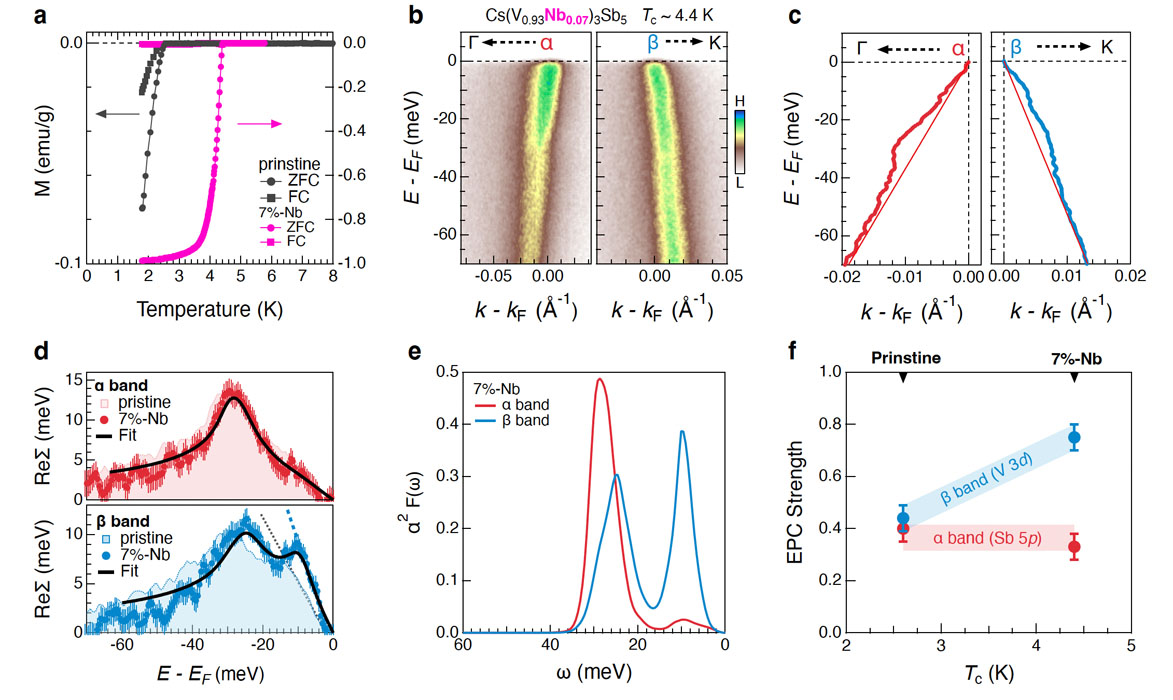Testing Electron-phonon Coupling for Superconductivity in Kagome Metal CsV3Sb5
Okazaki and Kondo Groups
In crystalline materials, electron-phonon coupling (EPC) is a ubiquitous many-body interaction that drives conventional Bardeen-Cooper-Schrieffer superconductivity. Recently, in a new kagome metal CsV3Sb5, superconductivity that possibly intertwines with time-reversal and spatial symmetry-breaking orders is observed [see phase diagram in Fig. 1a]. Density functional theory (DFT) calculation [1] predicted a weak EPC strength, λ, supporting an unconventional pairing mechanism in CsV3Sb5. However, experimental determination of λ is still missing, hindering a microscopic understanding of the intertwined ground state of CsV3Sb5. In this study, using 7-eV laser-based angle-resolved photoemission spectroscopy (ARPES) and Eliashberg function analysis, we experimentally extract the orbital- and momentum-dependent λ by determining the EPC-induced kinks in the electronic band structure.

Fig. 1. Orbital and momentum dependence of EPC in CsV3Sb5 kagome superconductor. (a) Phase diagram and crystal structure (inset). (b) Fermi surface mapping with ARPES intensity integrated within EF ± 5 meV. (c) ARPES intensity plot for a black cut in (b). (d) Extracted self-energy from the ARPES intensity plot shown in (c). (e) Real-part self-energy for the α and β bands along the Γ-K direction. (f) Extracted Eliashberg function for the α and β bands by fitting ReΣ(ω) in (e). (g) EPC strength λdev at different momenta on the α and β Fermi surfaces.
We first present the Fermi surface (FS) topology of CsV3Sb5 in Fig. 1b. In agreement with DFT study and previous ARPES studies [1, 2], the Sb 5p-band forms a circular FS, marked as α, at the BZ center and the V 3d-bands yield hexagonal and triangular FSs, marked as β and δ in Fig. 1b, respectively. Figure 1c shows a typical ARPES intensity plot of the α band corresponding to the black cut shown in Fig. 1b. By fitting momentum distribution curves (MDCs) with a Lorentzian function as the yellow and black curves shown in Fig. 1c, the band dispersion ω(k) is extracted as the red curve in Fig. 1c and the single-particle self-energy, Σ(ω = E − EF), is quantitively extracted in Fig. 1d. At EB ~ 32 meV, a peak in the real part ReΣ(ω) and a step jump in the imaginary part ImΣ(ω) prove a strong coupling between electrons and bosonic modes [3], which are manifested as a kink in the band structure. As the kink is persistent above the CDW transition temperature and any magnetic orders are absent, we attribute it to EPC.
Next, we study the orbital-dependence of EPC by comparing the kinks on the α and β bands. As in Fig. 1e, ReΣ(ω) of the β band which is derived from V 3d orbitals shows a peak near EB ~ 12 meV, suggesting a strong d-electron-phonon coupling near 12 meV. In contrast, ReΣ(ω) of the α band only shows a broad shoulder. Through a fit to the extracted ReΣ(ω) following the maximum energy method [3], we extract the Eliashberg function, α2F(ω). The extracted α2F(ω) for the α and β bands are plotted in Fig. 1f. The orbital dependence of the EPC is mirrored in the different shapes of α2F(ω), where phonon modes near 32 meV are accounted for 70% of the total EPC strength on the α band, λp, but less than 50% for the EPC strength on the β band, λd. Interestingly, due to the spectral weight redistribution in α2F(C [shaded area in Fig. 1f], λp and λd calculated by
2∫
The orbital- and momentum-dependent results demonstrate that λ in CsV3Sb5 falls in the intermediate range of 0.45 – 0.6, which is about 2 times larger than the previous DFT predicted λDFT ~ 0.25 [1]. Using McMillan’s formula and taking the lower and upper limits of the experimentally estimated λ and the logarithmic mean phonon frequency ~17.1 meV obtained by
2/λ∫

Fig. 2. Orbital and energy selective enhancement of EPC in 7%-Nb doped CsV3Sb5. (a) Temperature dependence of magnetic susceptibility. Both zero-field cooling (ZFC) and field cooling (FC) curves are presented. (b) ARPES intensity plots of the α and β bands along the Γ-K direction. (c) Extracted band dispersions. (d) Extracted real-part self-energy for the α (top panel) and β (bottom panel) bands. Colored shadows are the corresponding ReΣ(ω) for pristine CsV3Sb5. The dashed lines in bottom panel represent the slope of ReΣ(ω) at EF. (e) Extracted Eliashberg function. (f) EPC strength estimated from the Eliahsberg function and plotted as a function of Tc.
As Tc of CsV3Sb5 can be increased with chemical substitutions or external pressure (Fig. 1a). We thus continue to examine the EPC strength in 7% Nb-doped Cs(V0.93Nb0.07)3Sb5 with Tc ~ 4.4 K. Electronic kinks are observed on both the α and β bands as shown in Fig. 2b for the ARPES intensity plots and Fig. 2c for the extracted band dispersions. Figure 2d shows the extracted ReΣ(ω) on the α and β bands of Cs(V0.93Nb0.07)3Sb5. Remarkably, we observe that while ReΣ(ω) on the α band is similar in Cs(V0.93Nb0.07)3Sb5 and CsV3Sb5, on the β band, it shows a strong enhancement in the Nb-doped sample, especially near EB ~ 10 meV. Based on the extracted α2F(ω), shown in Fig. 2e, we find that λd ~ 0.75 ± 0.05 is enhanced by about 50% in Cs(V0.93Nb0.07)3Sb5 (Fig. 2f). Importantly, the enhanced λd is expected to elevate Tc up to 4.5 K, which is comparable to the experimental value of 4.4 K. Such synchronous enhancements of λd and Tc may indicate that the V 3d-electron–phonon couplings are the main driver of the superconductivity in CsV3Sb5.
In summary, by investigating the electronic kinks, we determined the intermediate EPC that is twice larger than the DFT calculation in the kagome superconductors CsV3Sb5 and Cs(V0.93Nb0.07)3Sb5. Our results provide an important clue to understand the pairing mechanism in CsV3Sb5. The orbital and momentum dependence of the electronic kinks and their strengthening with the promoted Tc prove that the EPC in CsV3Sb5 is strong enough to support Tc comparable to the experiment value and hence cannot be excluded as a possible pairing mechanism.
References
- [1] H. Tan et al., Phys. Rev. Lett. 127, 046401 (2021).
- [2] B. Ortiz et al., Phys. Rev. Lett. 125, 247002 (2020).
- [3] Y. Zhong et al., Nat. Commun. 14, 1945 (2023).
